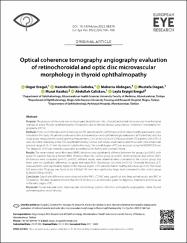Optical coherence tomography angiography evaluation of retinochoroidal and optic disc microvascular morphology in thyroid ophthalmopathy

Göster/
Erişim
info:eu-repo/semantics/openAccessTarih
2022Yazar
Erogul, ÖzgürGobeka, Hamidu Hamisi
Akdoğan, Müberra
Doğan, Mustafa
Kasıkcı, Murat
Çalışkan, Abdullah
Eryiğit Erogul, Leyla
Üst veri
Tüm öğe kaydını gösterKünye
Erogul, O., Gobeka, H. H., Akdogan, M., Dogan, M., Kasikci, M., Caliskan, A., & Erogul, L. E. (2022). Optical coherence tomography angiography evaluation of retinochoroidal and optic disc microvascular morphology in thyroid ophthalmopathy. EUROPEAN EYE RESEARCH, 2(4), 160-166.Özet
Purpose: The purpose of the study was to investigate detailed optic disc, choroid, and retinal microvascular morphological changes in active Thyroid ophthalmopathy (TO) patients due to thyroid disease using Optical Coherence Tomography An- giography (OCTA). Methods: Forty-six (34 females and 12 males) active TO patients and 41 (28 females and 13 males) healthy participants were included in the study. All patients underwent clinical examinations and ophthalmologic evaluations at first and last visits for visual acuity measurement, eyelid opening measurement, Clinical Activity Score (CAS) assessment (TO patients with CAS ≥3 were recorded, indicating active TO), exophthalmometry, cornea, and fundus examination, and those with initial intraocular pressure range of 14–21 mm Hg were included in the study. The overall degree of TO was assessed using the NOSPECS Score. The diagnosis of TO was made by a specialist according to the Bartley and Gorman Criteria. Results: The mean retinal nerve fiber layer (RNFL) thickness was significantly different between the groups (p<0.001), with active TO patients having a thinner RNFL thickness than the control group (p<0.001). When temporal and inferior RNFL thicknesses were compared (p=0.01, p=0.01), different results were obtained when compared to the control group, but there were no significant differences in upper and nasal RNFL thicknesses (p=0.604, p=0.513). Choroidal thickness (CT) measurements were significantly higher in the macular region in TO patients than in healthy individuals (p<0.05). The mean FAZ area in the TO group was found to be 0.303±0.104 mm2 at a significantly larger level compared to the control group (0.260±0.100) (p=0.037). Conclusion: Significant differences were detected in the RNFL, CT, FAZ area, superficial and deep retinal vessels, and RPC in TO patients. The data obtained showed that the OCTA device is an important guide for diagnosis, treatment and follow-up in the early stages of TO.















